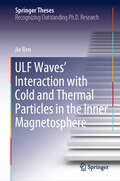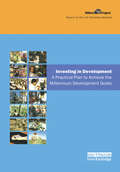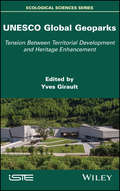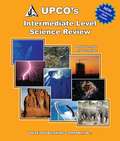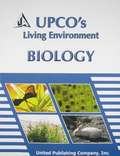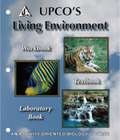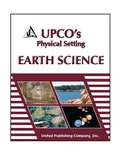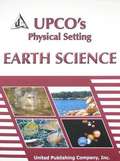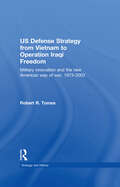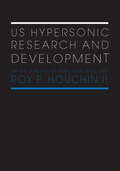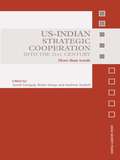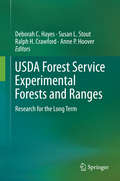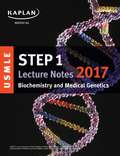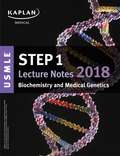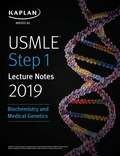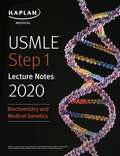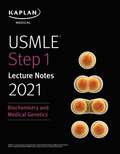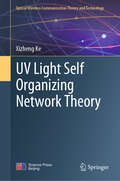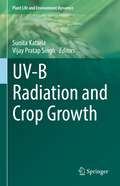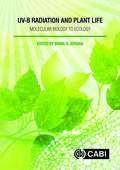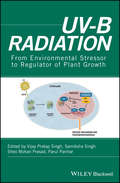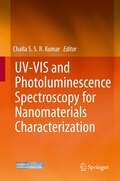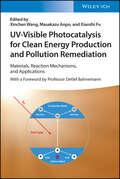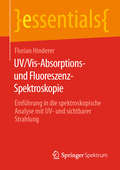- Table View
- List View
ULF Waves’ Interaction with Cold and Thermal Particles in the Inner Magnetosphere (Springer Theses)
by Jie RenThis thesis focuses on ULF (Ultra-low-frequency) waves' interaction with plasmasphere particles and ring current ions in the inner magnetosphere. It first reports and reveals mutual effect between ULF waves and plasmasphere using Van Allen Probes data. The differences and similarities of different ring current ions interacting with ULF waves are extensively explored using Cluster data, which provides a potential explanation for O+-dominated ring current during the magnetic storms. Furthermore, this thesis finds a method to study the phase relationship between ULF waves and drift-bounce resonant particles, and proposes that the phase relationship can be used to diagnose the parallel structure of standing wave electric field and energy transfer directions between waves and particles. The findings in this thesis can significantly promote our understanding of ULF waves' role in the dynamics of inner magnetosphere.
UN Millennium Development Library: A Practical Plan to Achieve the Millennium Development Goals
by Jeffrey D. Sachs The UN ProjectThis book describes the importance of the millennium development goals and gives an explanation of the progress toward the goals. It provides recommendations to be implemented at the country level and presents a guide for the international system's support for the country-level processes.
UNESCO Global Geoparks: Tension Between Territorial Development and Heritage Enhancement
by Yves GiraultRecently, UNESCO has gradually started to recognize world geoparks ? territorial spaces with a geological heritage of international importance. This classification presents real challenges. Development strategies must align with the recommendations advocated by various non-governmental organizations. It is also necessary to involve the local actors, both in the preparation of application forms and in the implementation of a management plan that is suitable for sustainable global development. Managing the tensions and asymmetries that exist between the different groups of actors (politicians, managers, scientists, representatives of local populations) constitutes another major issue. It is in this context and through various case studies that this book questions the aims of the UNESCO global geoparks ? in terms of heritage inventory and conservation, the participation of local populations, the local development of a territory and its enhancement through heritage interpretation.
UPCO's Intermediate Level Science Review
by Amy Schneider Peggy LomagaChapters include: Scientific Method; Chemistry of Matter; Characteristics of Life; Ecology; Physiology; Reproduction and Development; Genetics; Astronomy; Meteorology; Geology; Energy, Forces & Motion; Sound and Electromagnetic Energy.
UPCO's Intermediate Level Science Review
by United Publishing CompanyThe thirteen chapters cover: The Living Environment and The Physical Setting for students in Grades 5 through 8. Along with a General Science Skills Chapter. The chapter review involves application of concepts, reading comprehension, graphing, experimental design and analysis as well as important vocabulary words boldfaced throughout the chapters. It includes the NYS Intermediate Science Test Sampler as well as two additional practice exams at the end of the book.
UPCO's Living Environment Review: Biology
by Lorraine GodlewskiUPCO'S Living Environment Review is a complete review of all the key ideas and major understandings as required by the New York State Living Environment Core Curriculum. Also included is any additional information necessary for total comprehension of core curriculum key ideas.
UPCO's Living Environment: An Activity-oriented Biology Course
by Lorraine GodlewskiBiology is the name of the science that studies living things and their relationship to their environment. You should have a basic scientific knowledge, called scientific literacy, of your living and nonliving environment because scientific literacy involves internalizing a scientific critical attitude that can be applied to your life. It will help you to be better informed when making important decisions about your everyday life, particularly in relation to your health, and to issues concerning commercial and technological claims concerning the environment. Understanding the scientific view of the natural world is an essential part your personal, societal, and ethical decision making. The study of the living environment will also help you understand and apply scientific concepts, principles, and theories pertaining to the physical setting and the living environment and to recognize the historical development of ideas in science.
UPCO's Physical Setting Review: Earth Science
by Robert B. SigdaThe content of this book is aligned with the New York State Core Curriculum for Physical Setting/Earth Science. Throughout the book there is ample opportunity for review of basic skills and ways to tie in the various units.
UPCO's Physical Setting Review: Earth Science (Revised Edition)
by Robert SigdaWhen you look at the stars or feel the force of the wind, you are making observations. An observation is an interaction of one or more of the senses-sight, hearing, touch, taste, or smell-with the environment or surroundings. The ability of the senses are limited. Therefore, instruments have been invented and developed to extend the powers of observation. Instruments improve our ability to observe and to make measurements that would otherwise be very inaccurate or even impossible to make. For example, a telescope allows us to take a closer look at the stras. A scale enables us to accurately determine how much we weigh by measuring the pull of Earth's gravity on our bodies, which is something our senses don't readily observe.
US Defence Strategy from Vietnam to Operation Iraqi Freedom: Military Innovation and the New American War of War, 1973-2003 (Strategy and History)
by Robert R. TomesUS Defence Strategy from Vietnam to Operation Iraqi Freedom examines the thirty-year transformation in American military thought and defence strategy that spanned from 1973 through 2003. During these three decades, new technology and operational practices helped form what observers dubbed a 'Revolution in Military Affairs' in the 1990s and a 'New American Way of War' in the 2000s. Robert R. Tomes tells for the first time the story of how innovative approaches to solving battlefield challenges gave rise to non-nuclear strategic strike, the quest to apply information technology to offset Soviet military advantages, and the rise of 'decisive operations' in American military strategy. He details an innovation process that began in the shadow of Vietnam, matured in the 1980s as Pentagon planners sought an integrated nuclear-conventional deterrent, and culminated with battles fought during blinding sandstorms on the road to Baghdad in 2003. An important contribution to military innovation studies, the book also presents an innovation framework applicable to current defence transformation efforts. This book will be of much interest to students of strategic studies, US defence policy and US politics in general.
US Hypersonic Research and Development: The Rise and Fall of 'Dyna-Soar', 1944-1963 (Space Power and Politics)
by Roy F. Houchin IIAn essential new account of some of the most valuable research and development in international military history. Roy F. Houchin II shows how the roots of US Air Force hypersonic research and development are grounded in Army Air Force General Henry H. 'Hap' Arnold's identification of the need for advanced airpower weapon systems to meet the anticipated postwar enemy threat. The technology for a smooth transition to military spaceflight seemed within reach when Bell Aircraft Corporation executive Walter Dornberger (the former commander of Nazi Germany's V-2 rocket research) made an unsolicited proposal to William E. Lamar (the chief of Wright Aeronautical Development Center's New Development Office of the Bomber Aircraft Division at Wright-Patterson AFB, OH) for a hypersonic boost-glide weapon system. Visionaries like Arnold, Dornberger, and Lamar believed a hypersonic boost-glider would represent the ultimate expression of the US Air Force's doctrine by performing strategic bombardment and reconnaissance more successfully any other type of vehicle. As this aspiration reached maturity in Dyna-Soar, the service's leadership never gave up their beliefs. This book shows how the struggle to persuade the secretary of defence and his advisors, who did not share the Air Force's vision for a military spaceplane, illustrates the ebb and flow of an advanced technology program and its powerful legacy within American society.
US-Indian Strategic Cooperation into the 21st Century: More than Words (Asian Security Studies)
by Sumit Ganguly Andrew Scobell Brian ShoupIn this edited book, leading scholars and analysts trace the origins, evolution and the current state of Indo-US strategic cooperation. During the Cold War, owing to opposing grand strategies, the two states frequently found themselves at odds. With the end of the Cold War and the demise of the Soviet Union, Indo-US security cooperation started in a fitful fashion, but in recent years it has acquired considerable stability. The armed forces of the two states have participated in exercises on land, sea and air and have also carried out joint humanitarian missions. Drawing on new information and with contributions from both academics and policy makers, this wide-ranging volume analyzes the strategic convergence of the world’s two largest democracies, whilst explaining why important differences do remain. These notably include questions pertaining to the future of India’s nuclear and ballistic missile programs, US-Pakistan ties and India’s links with Iran. This volume will be of great interest to students of South Asian politics, Asian security, US foreign policy and security studies in general.
USDA Forest Service Experimental Forests and Ranges
by Deborah C. Hayes Susan L. Stout Ralph H. Crawford Anne P. HooverUSDA Forest Service Experimental Forests and Ranges (EFRs) are scientific treasures, providing secure, protected research sites where complex and diverse ecological processes are studied over the long term. This book offers several examples of the dynamic interactions among questions of public concern or policy, EFR research, and natural resource management practices and policies. Often, trends observed - or expected -- in the early years of a research program are contradicted or confounded as the research record extends over decades. The EFRs are among the few areas in the US where such long-term research has been carried out by teams of scientists. Changes in society's needs and values can also redirect research programs. Each chapter of this book reflects the interplay between the ecological results that emerge from a long-term research project and the social forces that influence questions asked and resources invested in ecological research. While these stories include summaries and syntheses of traditional research results, they offer a distinctly new perspective, a larger and more complete picture than that provided by a more typical 5-year study. They also provide examples of long-term research on EFRs that have provided answers for questions not even imagined at the time the study was installed.
USMLE Step 1 Lecture Notes 2017: Biochemistry and Medical Genetics
by Kaplan MedicalThe only official Kaplan Lecture Notes for USMLE Step 1 cover the comprehensive information you need to ace the exam and match into the residency of your choice. * Up-to-date: Updated annually by Kaplan’s all-star faculty * Integrated: Packed with clinical correlations and bridges between disciplines * Learner-efficient: Organized in outline format with high-yield summary boxes * Trusted: Used by thousands of students each year to succeed on USMLE Step 1
USMLE Step 1 Lecture Notes 2018: Biochemistry and Medical Genetics
by Kaplan MedicalKaplan Medical's USMLE Step 1 Lecture Notes 2018: Biochemistry and Medical Genetics offers in-depth review with a focus on high-yield topics – a comprehensive approach that will help you deepen your understanding while focusing your efforts where they'll count the most.Used by thousands of medical students each year to succeed on USMLE Step 1, Kaplan's official lecture notes are packed with full-color diagrams and clear review.The Best ReviewOrganized in outline format with high-yield summary boxes for efficient study.Clinical correlations and bridges between disciplines highlighted throughout.Full-color diagrams and charts for better comprehension and retention.Updated annually by Kaplan's all-star expert facultyLooking for more prep? Our USMLE Step 1 Lecture Notes 2018: 7-Book Set has this book, plus the rest of the 7-book series.
USMLE Step 1 Lecture Notes 2019: Biochemistry and Medical Genetics (Kaplan Test Prep)
by Kaplan MedicalThe only official Kaplan Lecture Notes for USMLE Step 1 cover the comprehensive information you need to ace the exam and match into the residency of your choice.Up-to-date: Updated annually by Kaplan’s all-star facultyIntegrated: Packed with clinical correlations and bridges between disciplinesLearner-efficient: Organized in outline format with high-yield summary boxesTrusted: Used by thousands of students each year to succeed on USMLE Step 1Looking for more prep? Our USMLE Step 1 Lecture Notes 2019: 7-Book Set has this book, plus the rest of the 7-book series.
USMLE Step 1 Lecture Notes 2020: Biochemistry and Medical Genetics (Kaplan Test Prep)
by Kaplan MedicalThe only official Kaplan Lecture Notes for USMLE Step 1 cover the comprehensive information you need to ace the exam and match into the residency of your choice. * Up-to-date: Updated annually by Kaplan&’s all-star faculty * Integrated: Packed with clinical correlations and bridges between disciplines * Learner-efficient: Organized in outline format with high-yield summary boxes * Trusted: Used by thousands of students each year to succeed on USMLE Step 1 Looking for more prep? Our USMLE Step 1 Lecture Notes 2018: 7-Book Set has this book, plus the rest of the 7-book series.
USMLE Step 1 Lecture Notes 2021: Biochemistry and Medical Genetics (USMLE Prep)
by Kaplan MedicalThe only official Kaplan Lecture Notes for USMLE Step 1 cover the comprehensive information you need to ace the exam and match into the residency of your choice. * Up-to-date: Updated annually by Kaplan&’s all-star faculty * Integrated: Packed with clinical correlations and bridges between disciplines * Learner-efficient: Organized in outline format with high-yield summary boxes * Trusted: Used by thousands of students each year to succeed on USMLE Step 1 Looking for more prep? Our USMLE Step 1 Lecture Notes 2018: 7-Book Set has this book, plus the rest of the 7-book series.
UV Light Self Organizing Network Theory (Optical Wireless Communication Theory and Technology)
by Xizheng KeThis book covers the basic concepts of UV communication, the analysis of UV channel characteristics, the organize media access protocols, and routing protocols, etc. in the network. Based on the analysis of classical communication protocols, a basic framework for UV self-organising networks is proposed. The communication protocol proposed in the book is analyzed in detail, and the key procedures of computer simulation are given at the end of the book so that readers can learn and understand.This book can guide senior undergraduate and postgraduate students of communications, networking, and other related majors in colleges and universities. It can also be used as a reference book for researchers and engineering technicians.
UV-B Radiation and Crop Growth (Plant Life and Environment Dynamics)
by Vijay Pratap Singh Sunita KatariaThis book is an inclusive collection of topics on research on UVB for its impact on plants with a focus on its use as an emerging technology for crop growth and protection. This book covers role of UV-B on biological systems, and its transformation from generic stressor to specific regulator. It also explores the past research in UVB studies and the changing mind-sets regarding UV-B in recent time with respect to the plant growth. It also explores the discovery of specific UV-B photoreceptor, UVR8 and UVR8 mediated plants responses. This book is of interest to teachers, researchers, agriculture scientists and plant physiologists. Also the book serves as additional reading material for undergraduate and graduate students of agriculture, forestry, ecology, soil science, and environmental sciences
UV-B Radiation and Plant Life
by Brian R. JordanUltraviolet-B radiation (UV-B) has profound effects on plant growth and development, and exposure varies with ozone depletion and across geographic regions, with ecosystem and agricultural consequences. This book deals with large-scale impacts but also how UV-B affects plants at the molecular level is also fascinating, and the UV-B photoreceptor has only recently been characterised. While UV-B radiation can be damaging, it also has a more positive role in plant photomorphogenesis. Consequently UV-B treatments are being developed as innovative approaches to improve horticulture. This book is a timely synthesis of what we know and need to know about UV-B radiation and plants.
UV-B Radiation: From Environmental Stressor to Regulator of Plant Growth
by Parul Parihar Samiksha Singh Sheo Mohan Prasad Vijay Pratap SinghUltraviolet B (UV-B) is electromagnetic radiation coming from the sun, with a medium wave which is mostly absorbed by the ozone layer. The biological effects of UV-B are greater than simple heating effects, and many practical applications of UV-B radiation derive from its interactions with organic molecules.Considered particularly harmful to the environment and living things, what have scientific studies actually shown? UV-B Radiation: From Environmental Stressor to Regulator of Plant Growth presents a comprehensive overview of the origins, current state, and future horizons of scientific research on Ultraviolet B radiation and its perception in plants. Chapters explore all facets of UV-B research, including the basics of how UV-B’s shorter wavelength radiation from the sun reaches the Earth’s surface, along with its impact on the environment’s biotic components and on human biological systems. Chapters also address the dramatic shift in UV-B research in recent years reflecting emerging technologies; showing how historic research which focused exclusively on the harmful environmental effects of UV-B radiation has now given way to studies on potential benefits to humans. Topics include:• UV-B and its climatology• UV-B and terrestrial ecosystems• Plant responses to UV-B stress• UB- B avoidance mechanisms• UV-B and production of secondary metabolites • Discovery of UVR8 Timely and important, UV-B Radiation: From Environmental Stressor to Regulator of Plant Growth is an invaluable resource for environmentalists, researchers and students, into the state-of-the-art research being done on exposure to UV-B radiation.
UV-VIS and Photoluminescence Spectroscopy for Nanomaterials Characterization
by Challa S.S.R. KumarSecond volume of a 40-volume series on nanoscience and nanotechnology, edited by the renowned scientist Challa S.S.R. Kumar. This handbook gives a comprehensive overview about UV-visible and photoluminescence spectroscopy for the characterization of nanomaterials. Modern applications and state-of-the-art techniques are covered and make this volume essential reading for research scientists in academia and industry in the related fields.
UV-Visible Photocatalysis for Clean Energy Production and Pollution Remediation: Materials, Reaction Mechanisms, and Applications
by Masakazu Anpo Xianzhi Fu Xinchen WangUV-Visible Photocatalysis for Clean Energy Production and Pollution Remediation Comprehensive resource detailing fundamentals of photocatalysis, clean energy production, and pollution treatment, as well as recent developments in each field UV-Visible Photocatalysis for Clean Energy Production and Pollution Remediation: Materials, Reaction Mechanisms, and Applications provides current developments in photocatalytic reactions for both inorganic and organic-based materials which operate under UV-visible light or sunlight irradiation, with a focus on the fundamentals and applications in clean energy production and pollution remediation. The text curates interesting and important research surrounding photocatalysis for hydrogen production, including the fundamentals and photocatalytic remediation of our better environments, which covers the reduction of CO2 and fixation of N2 with H2O under UV-visible light or sunlight irradiation. The first chapter of the book introduces these diverse subjects by including a brief history of the developments of photocatalysis research since around the 1960s. Specific sample topics covered in this book include: Visible-light active photocatalysts in pollutant degradation and conversion with simultaneous hydrogen production Application of S-scheme heterojunction photocatalyst and the role of the defects on the photocatalytic reactions on ZnO Strategies for promoting overall water splitting with particulate photocatalysts via single-step visible-light photoexcitation Polymeric carbon nitride-based materials in aqueous suspensions for water photo-splitting and photo-reforming of biomass aqueous solutions to generate H2 Visible light-responsive TiO2 thin film photocatalysts for the separate evolution of H2 and O2 from water For chemists, scientists, physicists, and engineers across a wide range of disciplines, UV-Visible Photocatalysis for Clean Energy Production and Pollution Remediation is an essential resource for understanding current developments in photocatalytic reactions on both inorganic and organic-based materials which operate under UV-visible light or sunlight irradiation.
UV/Vis-Absorptions- und Fluoreszenz-Spektroskopie: Einführung in die spektroskopische Analyse mit UV- und sichtbarer Strahlung (essentials)
by Florian HindererFlorian Hinderer bietet in diesem essential eine leicht verständliche Einführung in Methoden der optischen Spektroskopie. Kurz und präzise, strukturiert und gut zu lesen vermittelt er die Grundlagen der UV/Vis-Absorptions- und Fluoreszenz-Spektroskopie. Vom Grundprinzip und den typischen Anwendungsgebieten der UV/Vis-Absorptions-Spektroskopie führt der Autor zu einem detaillierten Verständnis dieser Methode. Er gibt dafür einen Überblick über Grundlagen zu Auswahlregeln und zeigt die typischen Spektren organischer und anorganischer Moleküle. Ein Kapitel zu den Konzepten der Fluoreszenz-Spektroskopie sowie weiterführende Literatur runden das essential ab.
